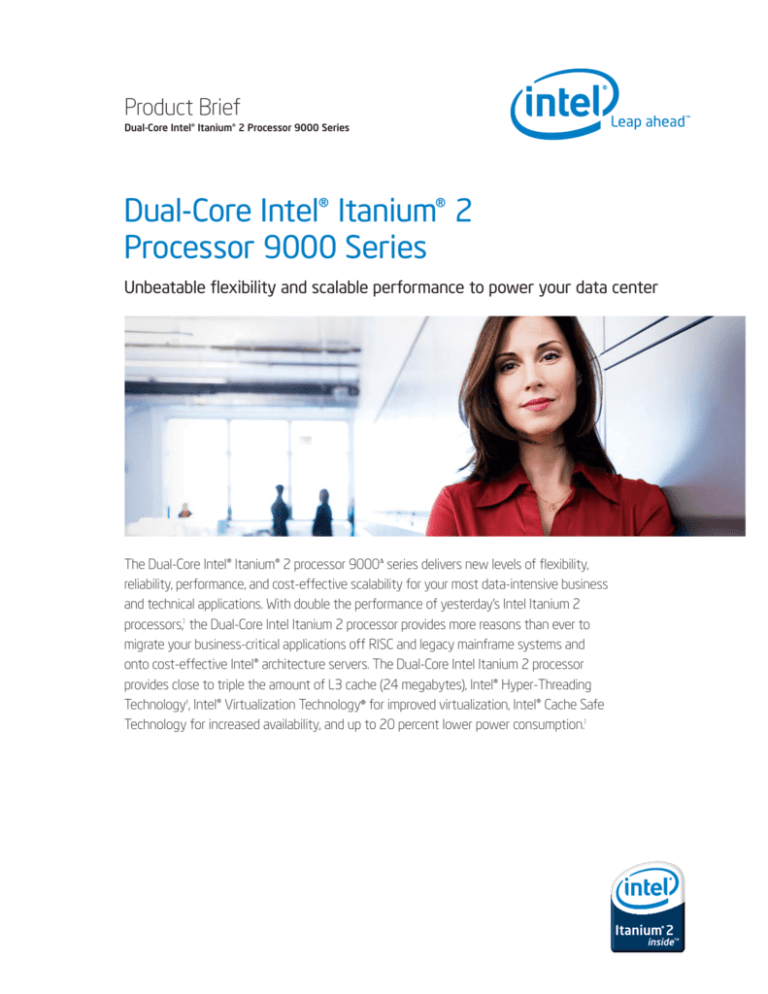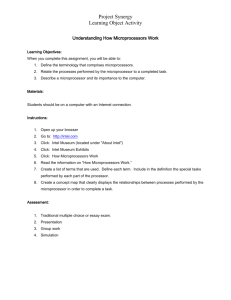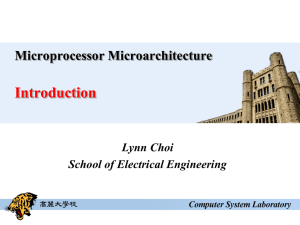
Product Brief
Dual-Core Intel® Itanium® 2 Processor 9000 Series
Dual-Core Intel® Itanium® 2
Processor 9000 Series
Unbeatable flexibility and scalable performance to power your data center
The Dual-Core Intel® Itanium® 2 processor 9000Δ series delivers new levels of flexibility,
reliability, performance, and cost-effective scalability for your most data-intensive business
and technical applications. With double the performance of yesterday’s Intel Itanium 2
processors,1 the Dual-Core Intel Itanium 2 processor provides more reasons than ever to
migrate your business-critical applications off RISC and legacy mainframe systems and
onto cost-effective Intel® architecture servers. The Dual-Core Intel Itanium 2 processor
provides close to triple the amount of L3 cache (24 megabytes), Intel® Hyper-Threading
Technology†, Intel® Virtualization TechnologyΦ for improved virtualization, Intel® Cache Safe
Technology for increased availability, and up to 20 percent lower power consumption.1
Make the Move to Dual-Core
Itanium® 2-based Servers
The hardware and software support you need to migrate
RISC and mainframe applications is here today.
Dual-Core Itanium® 2-based systems are available from leading
OEMs worldwide and run popular 64-bit operating systems
such as Microsoft Windows Server 2003*; Linux* from Novell,
Red Hat, Red Flag, and other distributors; HP NonStop*;
OpenVMS*; HP-UX*; Bull GCOS 8*, and NEC ACOS-4*. More
than 8,000 applications2 are available for Itanium 2-based
systems from vendors such as Microsoft, BEA, IBM, Ansys,
Gaussian, Symantec/Veritas, Oracle, SAP, and SAS. And with
industry support growing and future Intel® Itanium® processor
family advances already in development, your Dual-Core Itanium
2-based server investment will continue to deliver performance
advances and savings for your most demanding applications.
2
Nonstop Innovation
EPIC Architecture. Explicitly Parallel Instruction Computing
Intel Cache Safe Technology. This new technology enables
(EPIC) architecture is the cornerstone of the Intel Itanium
high-end systems to operate even in the event of errors in
architecture. It provides a variety of advanced implementations
the L3 cache that can bring systems down. Intel Cache Safe
of parallelism, predication, and speculation, resulting in superior
Technology minimizes cache errors and helps ensure
Instruction-Level Parallelism (ILP) to help address the current and
mainframe-caliber availability.
future requirements of high-end enterprise and technical workloads. This architecture is built from the ground up for the most
demanding applications, made possible by high levels of compute
parallelism, massive caches, and processor execution resources.
Outstanding Energy Efficiency. The Dual-Core Intel Itanium 2
processor uses up to 20 percent less power than yesterday’s
Intel Itanium 2 processor, enabling 2.5 times higher performance
per watt, lowering energy requirements while providing signifi-
Dual-Core Processing. The Dual-Core Intel Itanium 2 processor
cant performance improvements.1
is Intel's first product in the Itanium processor family with two
complete 64-bit cores on one processor.
Impressive Price/Performance. Dual-Core Intel Itanium 2
processors continue the Intel Itanium processor family legacy
Intel Hyper-Threading Technology. The Dual-Core Intel
of providing extremely attractive price/performance for
Itanium 2 processor is also the first member of the Intel Itanium
data-intensive applications. They provide mainframe-class
processor family to include Hyper-Threading Technology, which
performance, and reliability without the mainframe price tag.
provides four times the number of application threads provided
by earlier single-core implementations.
Security Features. The Intel Itanium 2 processor has a number
of unique features to support best-in-class data center
24 MB On-Die L3 Cache. The Dual-Core Intel Itanium 2
security. These include faster data encryption, robust memory
processor features up to 24 megabytes of low-latency on-die
compartmentalization (via enhanced paging architecture),
L3 cache, nearly three times the amount provided by yesterday’s
and hardware authentication of firmware.
Intel Itanium 2 processor, providing high bandwidth to the two
cores. This generous on-die L3 cache combined with dual-core
processing and Hyper-Threading Technology provides twice the
performance of yesterday’s Intel Itanium 2 processor.1
IA-32 Application Support. Itanium 2-based servers have
always supported IA-32 application to ease the transition for
customers migrating from other processor architectures. The
IA-32 Execution Layer enhances this capability, providing
Intel Virtualization Technology. The Dual-Core Intel Itanium 2
improved performance and flexibility. The IA-32 Execution
processor includes hardware-assisted virtualization support that
Layer is supported by Microsoft Windows* and Linux*
helps increase virtualization efficiency and broaden operating
operating systems.
system compatibility. In conjunction with dual-core performance
improvements and unparalleled scalability advantages, Intel
Virtualization Technology makes Dual-Core Itanium 2-based
systems an excellent platform for data-intensive virtualization.
3
Server and High-Performance Computing Performance
Performance (Intel® Itanium® 2 processor 1.6 GHz with 24 MB L3 cache. Higher is better)
Baseline
Intel Itanium 2 processor 1.6 GHz with 9 MB L3 cache
1.0
OLTP
1.80
Linpack 2.1.3
1.94
SPECint_rate_base_2000
2.02
SPECjbb2005
2.10
ERP
2.16
0.0
0.5
1.0
1.5
2.0
2.5
Configuration details: Data Source: Intel Internal Measurement (March 2006)
Baseline: Intel® Itanium® 2 processor 1.6 GHz with 9 MB L3 cache
Benchmark description for OLTP: Measure of database performance in an online transaction processing. OLTP (NT/SQL). Intel® SR870BN4 Server System (Tiger 4): Dual-Core
Intel® Itanium® 2 “Montecito” 1.6 GHz. processors, 24 MB L3 cache, 1 MB L2I, 256K L2D, 16 KB, L1I, and 16 KB L1D. C0’ stepping, 400 MHz FSB, Memory: 64 GB
(16 x 4 GB DDR/PC2100, 266 MHz), SOEMT Enabled (BIOS default), Intel Itanium 2 “Madison” 1.6 GHz processors, 9MB L3 cache per CPU. A1 Stepping, 400 MHz FSB,
Memory: 64 GB (16 x 4 GB DDR/PC2100, 266 MHz).
Benchmark description for Linpack: Measure of CPU floating point performance. Linpack. Intel® SR870BN4 Server System (Tiger 4). CPU: 8 cores, 4 chips, 1chip/socket, 2
cores/chip “Montecito” C0’ stepping processors with 12 MB L3 cache/core at 1.60 GHz/400 MHz, SoEMT disabled (Hyper-Threading Technology disabled), CPU: 4 cores, 4
chips, 1chip/socket, 1core/chip “Madison” processors with 9 MB L3 cache at 1.60 GHz/400 MHz , System/Software (both systems): OS—Linux version 2.6.9-22.EL.
Benchmark description for SPECJBB2005: Measure of Web server performance. SPECjBB2005. Intel® SR870BN4 Server System (Tiger 4): CPU Info: 4 x Intel® Itanium®2
processor “Madison” 1.6 GHz with 9 MB L3 cache, Chipset: E8870, Memory: 16 GB (8 x 2 GB DDR/PC2100, 200 MHz), CPU Info: 4 x Intel Itanium 2 processor “Montecito”
1.6 GHz (C0’ stepping) with 24 MB L3 cache, SoEMT enabled, Chipset: E8870, Memory: 32 GB (16 x 2 GB DDR/PC2100, 200 MHz).
Benchmark description for SPECCPU2000 (SPECint_rate_base2000): Measure of CPU performance integer or floating point. SPECCPU2000. Intel® SR870BN4 Server
System (Tiger 4). CPU: 8 cores, 4 chips, 1chip/socket, 2 cores/chip Montecito C0’ stepping processors with 12 MB L3 cache/core at 1.60 GHz/400 MHz, SoEMT disabled
(Hyper-Threading Technology disabled), CPU: 4 cores, 4 chips, 1chip/socket, 1core/chip “Madison” processors with 9 MB L3 cache at 1.60 GHz/200 MHz, OS—RedHat EL4.0
Update-2 (2.6.9-22.1.EL on Montecito and 2.6.9-22.EL on Madison 9 MB), Application: CPU2000 version 1.2, Compilers: Intel® C++ / Fortran Compilers for Linux* version 9.1
Build 20060102.
Benchmark Description for ERP:
Intel® SR870BN4 MP Server System (Tiger 4)
Madison A1 Stepping 1.6 GHz/9 MB: 4P, 32 GB (16x2 DDR 266 MHz REG DIMMs)
Montecito C0’ Stepping 1.6 GHz (12 MB cache per core): 4 sockets, 8 cores, 16 threads
Operating system: SuSE* Linux* Enterprise Server 9 for IA64, Madison: Linux kernel 2.6.5-97-smp, Montecito: Linux kernel 2.6.5-139 (Montecito patch applied for multi-core
and multi-thread detection), Oracle9i* Enterprise Edition Release 9.2.0.4.0 64-bit production.
4
Dual-Core Intel® Itanium® 2 Processor and
IBM Power5* 4-Core Performance
Performance (Higher is better)
IBM Power5
1.000
Dual-Core Intel Itanium 2 processor
0.987
0.0
0.2
0.4
0.8
0.6
1.0
Dual-Core Intel® Itanium® 2 Processor and
IBM Power5* 4-Core Price/Performance
Price/performance (Lower is better)
IBM Power5
3.93
Dual-Core Intel Itanium 2 processor
2.75
0.0
1.0
2.0
3.0
4.0
Configuration details:
Source: www.tpc.org: IBM eServer* p5 570 4P, Power5* 1.9 GHz, 4P (2 processors, 4 cores, 8 threads), 128 GB memory, Oracle Database 10g Enterprise Edition*, IBM AIX 5L
V5.3*, result of 203,439 tpmC $3.93/tpmC, published on 10/17/05. Intel® Itanium® 2 processor results of 200,829 tpmC and $2.75/tpmC on HP Integrity rx4640* using 2
Intel Itanium 2 processors 1.6 GHz with 24 MB L3 cache (2 processors, 4 cores, 8 threads), 128 GB memory, Oracle Database 10g Enterprise Edition, HP-UX 11.iv2* 64-bit
base OS, was published on 03/21/06.
Find the latest Intel® Server Performance Benchmarks at
www.intel.com/performance/server/itanium2
5
Dual-Core Intel® Itanium® 2 Processor Reliability
Features
Functions
Benefits
Intel® Cache Safe Technology:
automatic cache recovery
Allows processor and server to continue normal
operation in case of cache error; automatically disables
cache lines in the event of cache memory error
• Greater ability to survive cache errors
• Higher levels of computing uptime
Enhanced Machine Check
Architecture: extensive error
detection and correction capabilities
Address and data path error correction; system-wide
ECC protection; automatic error detection, logging,
and correction
• Detect bit-level errors and manage data corruption,
thereby providing outstanding reliability for maximum
system uptime
ECC memory with mirroring,
redundancy, or Chipkill* capabilities;
hot-plug platform components like
supplies and disks; built-in hardware
redundancy; enhanced platformlevel manageability
Servers can detect, log, and correct errors and be
configured with many levels of redundancy; server
processor boards, memory, I/O, fans, power can be
serviced while still up and running with hot-plug
capabilities; servers can be managed remotely
• Servers are highly reliable, manageable, and easily
serviced, providing maximum uptime for
business-critical applications
Platform capabilities shown represent example high-end enterprise server capabilities and can vary based on vendor-specific platform features and target applications.
Optimized for Data-Intensive Computing
Dual-Core Itanium 2-based servers offer excellent price/performance and transaction speed for business analytics, databases, ERP, and
other data-intensive applications found in enterprise and technical computing environments.
Business Value
Features/Functions
Benefits
Powerful solutions for vast amounts of
data and users, data-intensive business
analytics, high-volume transactions,
and complex calculations
• Dual-core processor
• Low-latency 24 MB on-die L3 cache (14 cycles)
providing 102 GB/s aggregate bandwidth to the cores1
• 2.5 MB L2 and single-cycle latency L1
• 1.6 GHz frequency
• Supports 400 and 533 MHz bus speeds
• Explicit parallelism simultaneously executes multiple
instructions on each clock cycle
• High-precision floating-point architecture: speeds up
complex calculations
•Improved time to information and real-time
business decision making
•Faster access to data and improved throughput
for enterprise applications
• Fast responses to complex calculations
• Faster online transaction processing
Mainframe-class reliability and scalability
features for business-critical computing
• Intel® Cache Safe Technology
• Intel® Virtualization TechnologyΦ
•Automatic cache error recovery
•Greater virtualization efficiency, broader operating
system compatibility
• High reliability, availability, serviceability
and manageability
• Extensive error detection and correction capabilities
Intel volume economics extended to the
most data-intensive, critical applications
• Itanium® 2-based solutions are less expensive than
proprietary RISC offerings
• Strong Intel® Itanium® processor family roadmap
• Support from leading OS and application vendors
• Multiple future processors in development
• Most extensive OS and application support in industry
Price/performance advantage for
business analytics
• 1,024 terabytes of physical addressable memory
• Support for > 500 processor systems and clusters
of > 10,000 processors
• High-precision floating-point architecture
• Able to handle vast amounts of data, complex
calculations, and high-volume transactions
Low power
• Dual-core at 104 W
• Up to 20 percent lower power usage than previous
Intel® Itanium® 2 processor1
• Cost effective
• Improvement over prior-generation platforms3
6
What Is the 9000 Sequence?
At Intel, our processor sequence numbers help differentiate processor features beyond front-side bus speed and brand name. New
advancements in our processors, other than bus speed, such as architecture, cache, power dissipation, and embedded Intel® technologies,
contribute significantly to performance, power efficiency, and other end-user benefits. Our processor sequence will help developers decide
on the best processor for their platform designs, and help end-users understand all the characteristics that contribute to their overall experience.
Intel offers four processor number sequences for server applications.
Processor Sequence
Used For
Intel® Pentium® 4/Pentium® D processor
Small business, entry, or first server
Dual-Core Intel® Xeon® processor 5100Δ sequence
Volume DP servers/workstations based on the Intel Xeon processor
Dual-Core Intel® Xeon® processor 7000Δ sequence
Greater scalability than DP platforms, with MP enterprise servers based on the Intel Xeon processor MP
Dual-Core Intel® Itanium® 2 processor 9000Δ sequence
Maximum flexibility, reliability, performance, and cost-effective scalability for RISC and mainframe
replacement
Dual-Core Intel® Itanium® 2 Processor 9000 Series
Processor NumberΔ
Speed
Cache
Size
FrontSide Bus
Total
Dissipated
Power
HyperThreading
Technology†
Intel®
Cache Safe
Technology
Intel®
Virtualization
TechnologyΦ
64-bit
Support
Dual-Core Intel® Itanium® 2
processor 9050
1.60
24 MB L3
400/533
104 W
yes
yes
yes
yes
Dual-Core Intel® Itanium® 2
1.60
18 MB L3
400/533
104 W
yes
yes
yes
yes
Dual-Core Intel® Itanium® 2
processor 9030
1.60
8 MB L3
400/533
104 W
no
yes
yes
yes
Dual-Core Intel® Itanium® 2
processor 9020
1.42
12 MB L3
400/533
104 W
yes
yes
yes
yes
Dual-Core Intel® Itanium® 2
1.40
12 MB L3
400
104 W
yes
yes
yes
yes
1.60
6 MB L3
400/533
75 W
no
yes
yes
yes
processor 9040
processor 9015
Intel® Itanium® 2
processor 9010
Find out more about Dual-Core Intel® Itanium® 2 processors at
www.intel.com/itanium.
7
www.intel.com/itanium
Contacts
United States and Canada
Intel Corporation
Robert Noyce Building
2200 Mission College Blvd.
P.O. Box 58119
Santa Clara, CA 95052-8119
USA
Europe
Intel Corporation (UK) Ltd.
Pipers Way
Swindon
Wiltshire SN3 1RJ
UK
1
Asia-Pacific
Intel Semiconductor Ltd.
32/F Two Pacific Place
88 Queensway, Central
Hong Kong, SAR
South America
Intel Semiconductores do Brasil LTDA
Av. Dr. Chucri Zaidan, 940-10° andar
04583-904 São Paulo, SP
Brazil
Japan
Intel Japan (Tsukuba HQ)
5-6
Tokodai Tsukuba-shi
300-2635 Ibaraki-ken
Japan
Performance measured using OLTP (NT/SQL), SPECjbb2005, SPECCPU, Linpack, and SAP-SD. Intel Internal Measurement (March 2006)
comparing system configurations of Dual-Core Intel® Itanium® 2 processor 1.6 GHz with 24 MB L3 cache to Intel Itanium 2 processor
1.6 GHz with 9 MB L3 cache. Actual performance may vary. See http://www.intel.com/performance/server/itanium2.
2
Intel internal data collected as of June 2006.
3
Intel internal measurements on Intel® Server Platform SR870BH2 and based on integer and floating-point workloads.
Δ
Intel processor numbers are not a measure of performance. Processor numbers differentiate features within each processor family, not
across different processor families. See http://www.intel.com/products/processor_number for details.
†
Hyper-Threading Technology requires a computer system with an Intel® processor supporting HT Technology and a HT Technology
enabled chipset, BIOS and operating system. Performance will vary depending on the specific hardware and software you use. See
http://developer.intel.com/products/ht/Hyperthreading_more.htm for additional information.
Φ
Intel® Virtualization Technology requires a computer system with an enabled Intel® processor, BIOS, virtual machine monitor (VMM) and, for
some uses, certain platform software enabled for it. Functionality, performance or other benefits will vary depending on hardware and software configurations and may require a BIOS update. Software applications may not be compatible with all operating systems. Please check
with your application vendor.
Performance tests and ratings are measured using specific computer systems and/or components and reflect the approximate performance
of Intel products as measured by those tests. Any difference in system hardware or software design or configuration may affect actual performance. Buyers should consult other sources of information to evaluate the performance of systems or components they are considering
purchasing. For more information on performance tests and on the performance of Intel products, visit
http://www.intel.com/performance/resources/limits.htm or call (U.S.) 1-800-628-8686 or 1-916-356-3104.
Information in this document is provided in connection with Intel products. No license, express or implied, by estoppel or otherwise, to any
intellectual property rights is granted by this document. Except as provided in Intel’s Terms and Conditions of Sale for such products, Intel
assumes no liability whatsoever, and Intel disclaims any express or implied warranty, relating to sale and/or use of Intel products including
liability or warranties relating to fitness for a particular purpose, merchantability, or infringement of any patent, copyright or other intellectual property right. Intel products are not intended for use in medical, life saving, or life sustaining applications. Intel may make changes to
specifications and product descriptions at any time, without notice.
*Other names and brands may be claimed as the property of others.
Copyright © 2006 Intel Corporation. All rights reserved.
Intel, the Intel logo, Intel. Leap ahead., the Intel. Leap ahead. logo, Itanium 2, the Itanium 2 logo, the Intel Inside logo, Pentium, and Intel Xeon
are trademarks or registered trademarks of Intel Corporation or its subsidiaries in the United States and other countries.
Printed in USA
0606/JRR/OCG/XX/PDF
Please Recycle
313890-001US







